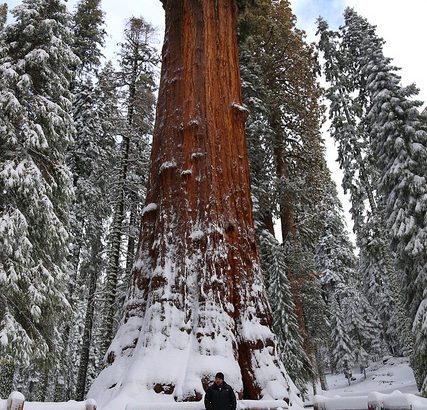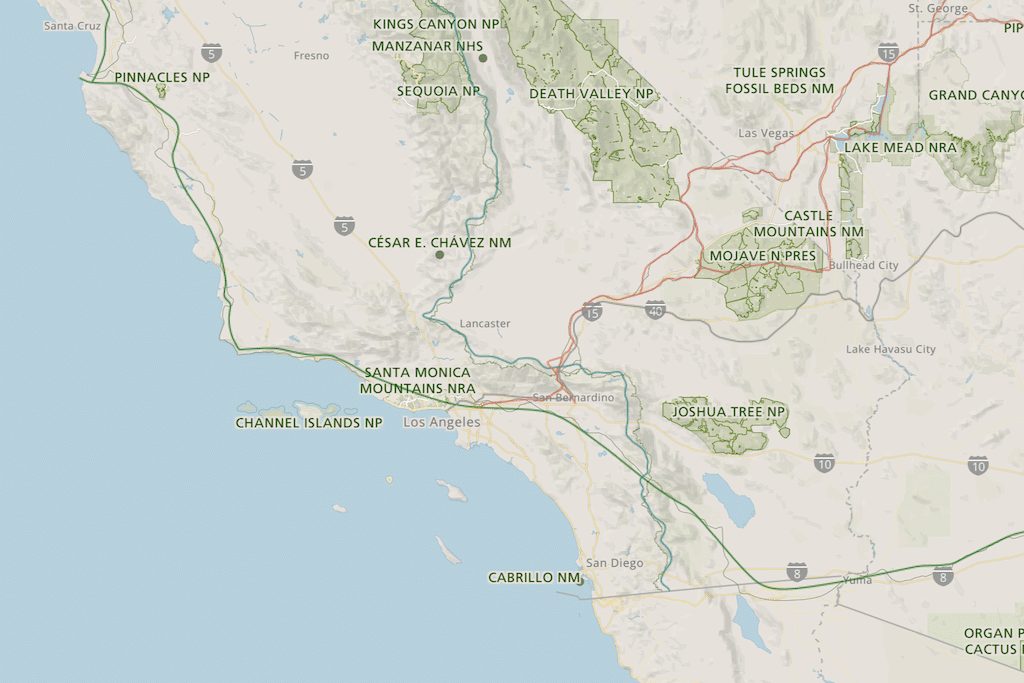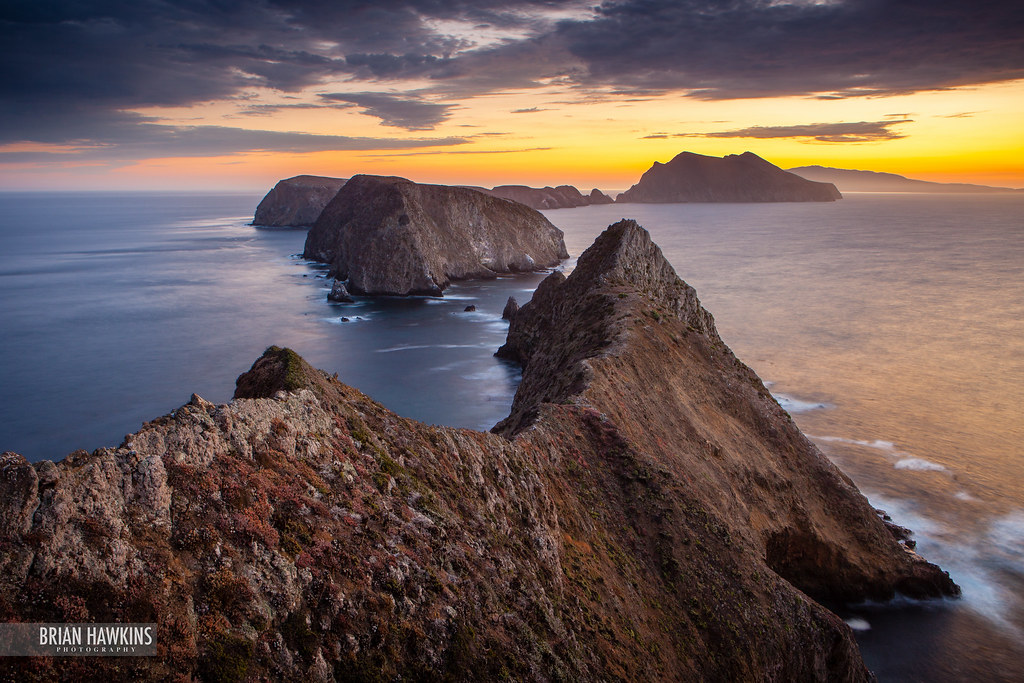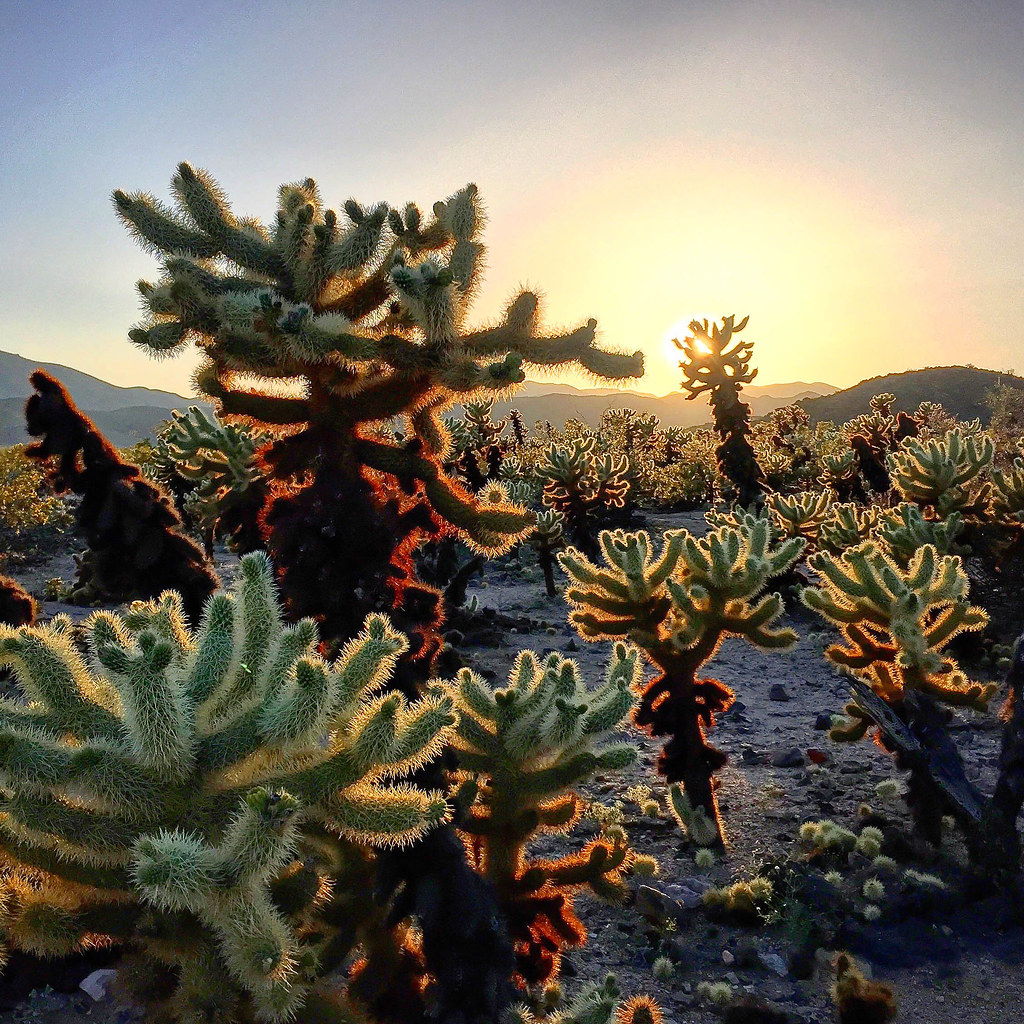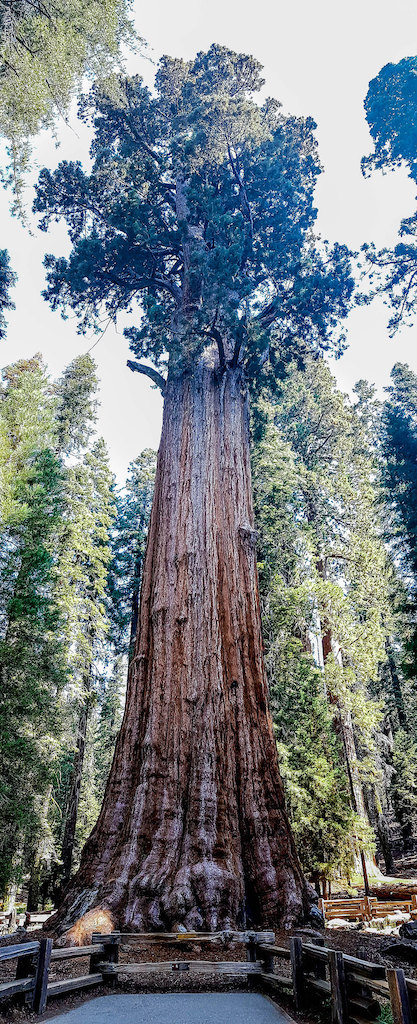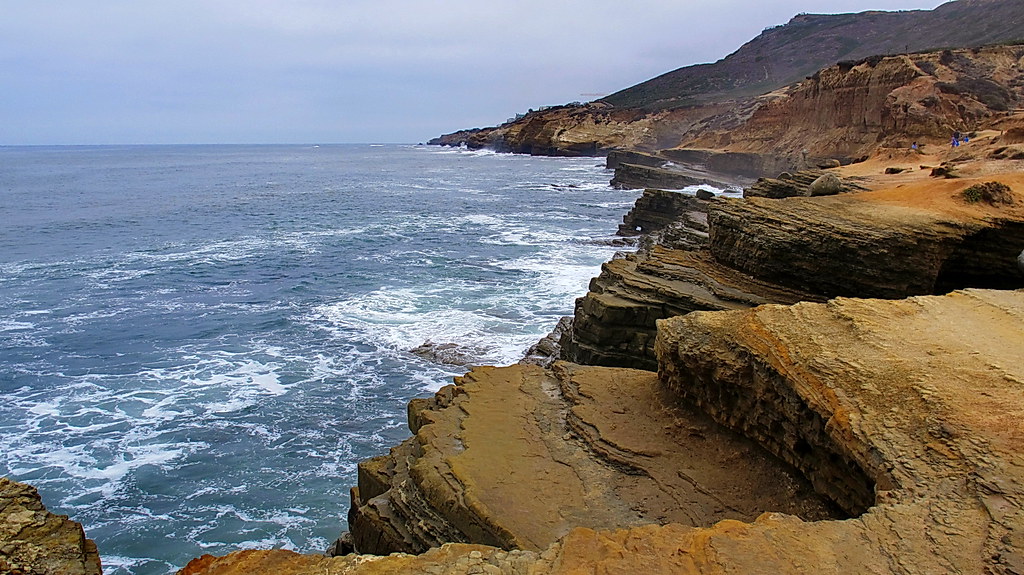There are a some unique national parks in Southern California (and national park sites) that each have something special to offer their visitors. From pristine islands rich in biodiversity to tall desert sand dunes, you can find something fun and interesting to do for just about anyone.
Here’s a guide to nine national parks in Southern California which include an array of national park sites, including national monuments and others.
Table of Contents
Southern California National Parks Map
Southern California is loaded up with national parks and you don’t have to venture far out from the major cities like Los Angeles to find some spectacular parks.
Joshua Tree National Park is only about two hours and 30 minutes outside of Los Angeles and Sequoia National Park is only three hours and thirty minutes from Los Angeles. Meanwhile the Santa Monica Mountains National Recreation Area is right in LA’s backyard.
If you think you might be bouncing between national parks then you might want to look into getting a national park annual pass to save money on park entry.
Tip: Use WalletFlo for all your credit card needs. It’s free and will help you optimize your rewards and savings!
Related: REI Co-op World Elite Mastercard Review
Southern California National Parks List
- Channel Islands National Park
- Death Valley National Park
- Joshua Tree National Park
- Sequoia National Park/ Kings Canyon National Park
- Cabrillo National Monument
- Castle Mountains National Monument
- César E. Chávez National Monument
- Mojave National Preserve
- Santa Monica Mountains National Recreation Area
1. Channel Islands National Park
Channel Islands National Park, referred to as the “Galapagos Islands of North America,” consists of five of the eight Channel Islands which are located not very far from the shores of Southern California.
Radiocarbon dating suggests that humans have inhabited the islands for over 30,000 years and the oldest known human remains ever discovered in North America were found here on Santa Rosa Island.
Today, the islands are known for being some of the most pristine areas of California that have been relatively unaffected by human development. It’s home to some pretty spectacular wildlife including the giant sea bass which can grow to over 7 feet long and the California spiny lobster, which can achieve lengths of over three feet.
There’s a ton of things to do at Channel Islands National Park. You can choose which island you’d like to visit though many head to Anacapa Island is because of the dramatic overlooks, one of which is the beautiful Inspiration Point.
Santa Cruz Island, the largest island in the state of California, is another one of the popular islands and is home to the most diverse range of flora and fauna, and one of the largest sea caves in the world.
While visiting Channel Islands National Park you can enjoy hiking, bird watching, kayaking, scuba diving, spear fishing, and many other activities. If you want to find out more about this destination, I suggest you read my article on Channel Islands National Park.
2. Death Valley National Park
Death Valley National Park straddles the border between California and Nevada. It’s the largest national park in the contiguous United States and comprises a stunning desert environment made up of salt-flats, sand dunes, badlands, valleys, canyons, and mountains.
Death Valley is also known for being the the hottest and driest place in North America.
In fact, on July 10, 1913, the United States Weather Bureau recorded the temperature at 134 °F (56.7 °C), which currently holds the record for the highest ambient air temperature ever recorded at the Earth’s surface.
So why would anybody be drawn here? Well, it’s not always that hot in Death Valley and it can actually be quite nice in the spring and fall. But there’s a ton of stunning scenery to check out at this vast national park.
One of the most interesting areas is the Racetrack. For years, scientists didn’t know how to explain the phenomenon that occurs there with the mysterious “sailing stones.”
People would find rocks scattered along a salt flat with long trails behind them showing that they had slid around. The only problem was that nobody had ever witnessed how it happened. Eventually, they were able to put it together though and they figured out the mystery.
3. Joshua Tree National Park
Joshua Tree National Park covers an expansive area slightly larger than the state of Rhode Island. This place was once inhabited by the Serrano, Cahuilla, and the Chemehuevi, all of which were hunter-gatherers who subsisted largely on plants and local small game, amphibians, and reptiles.
The name “Joshua tree” is believed to have derived from the times when Mormon settlers first crossed the Colorado River and encountered these unique trees in the mid 1800s. To them, the leaves resembled hands stretched out in supplication like the biblical figure, Joshua, and thus the name stuck.
Joshua trees aren’t actually trees (they’re yuccas) and they possess a number of fascinating features beyond their strange appearance.
There’s a lot to do at Joshua Tree National Park. You can choose from a number of hiking options, which range from easy to strenuous. Various forms of rock climbing are popular here and it’s where a lot of climbers go when some of the big walls in places like Yosemite Valley are too cold to climb in winter.
The diverse ecosystems produce varied wildlife at this national park in Southern California.
You can head to the Barker Dam, a short hike from a parking area near Hidden Valley, to scope out of the wildlife which could include Desert bighorn sheep and mule. Keep your eyes out on the ground as you might encounter the giant desert scorpion or even tarantulas.
The remaining places on the list are National Park sites like national monuments and national historic sites, which are lumped in as national parks since they are operated by the National Park Service.
4. Sequoia National Park/ Kings Canyon National Park
Sequoia National Park is where you can find the biggest tree in the world, known as the General Sherman. It stands 275 feet tall and is 25 feet in diameter. Its largest branch has a diameter of almost 7 feet, which is larger than most trees in the U.S. standing east of the Mississippi.
And it’s somewhere between 2,000 and 2,500 years old, so it’s older than the Colosseum.
There’s a lot to check out at this park beside the biggest tree in the world, though.
The Congress Trail is a popular paved loop trail that begins at the General Sherman Tree and offers some views of huge sequoias as well as groupings of smaller trees like the House and Senate. It’s a great stroll in the winter, too.
The Big Trees Trail is another popular option that starts off near the Giant Forest Museum and will offer an unforgettable experience with redwoods.
Plenty of other hiking options can be found at the park, too.
Moro Rock is another one of the prime attractions. It’s a giant granite dome that requires you to follow a stairway that climbs 300 feet up to the summit and offers a great view of the Great Western Divide and the western half of the park.
Grant Grove is another prime attraction located in Kings Canyon National Park. It’s a special grove with huge large sequoias grouped in a 90-acre area. The NPS notes that “[a] higher percentage of this grove’s mature sequoias reach sizes of ten, fifteen, and twenty feet (3, 4.5, or 6 m) in diameter than in any other grove.”
If you’re interested in exploring the other wooden giants in California known as redwoods then check out my article on the best places to see redwoods in California, which includes stunning spots like Redwood National Park.
Tip: Use WalletFlo for all your credit card needs. It’s free and will help you optimize your rewards and savings!
5. Cabrillo National Monument
Located at the southern tip of the Point Loma Peninsula in San Diego, California, Cabrillo National Monument commemorates the landing of Juan Rodríguez Cabrillo at San Diego Bay on September 28, 1542. This was the first time a European expedition set foot on the land that later became the West Coast of the United States.
One of the most popular attractions at the national monument are the tide pools, which contain a diverse range of marine life from octopus to bat stars and can be explored via a short hike. If you make your way up to the Whale Overlook station, you might be able so spot migrating grey whales.
Another attraction is the Point Loma Lighthouse which was put into service on November 15, 1855. It actually was built at an elevation too high at 422 feet above sea level, and so clouds and fog would shroud its light. This led to a new lighthouse being erected and almost resulted in the complete abandonment of the light house, though luckily it was preserved.
Today you can catch a variety of historical reenactments at the national monument like the annual Cabrillo Festival, which commemorated the arrival of Cabrillo.
6. Castle Mountains National Monument
Castle Mountains National Monument is one of the newest national monuments, designated back in 2016. The monument protects a section of the Castle Mountains, a range located in San Bernardino County and Clark County, Nevada and can only be accessed by dirt roads, so a high clearance, four-wheel drive vehicle is recommended.
If you take a look at the map of the national monument below, you’ll notice it has a very interesting shape. That’s because the monument surrounds the Castle Mountain Mine Area, which is an open pit gold mine owned by Canadian NewCastle Gold Ltd. They have the rights to excavate nearly 10 million tons of ore through the year 2025 (but mining has been suspended since 2001 due to low gold prices).
The national monument proclamation mandates that after the mining and reclamation is completed, the land in the Castle Mountain Mine Area will be transferred to the National Park Service
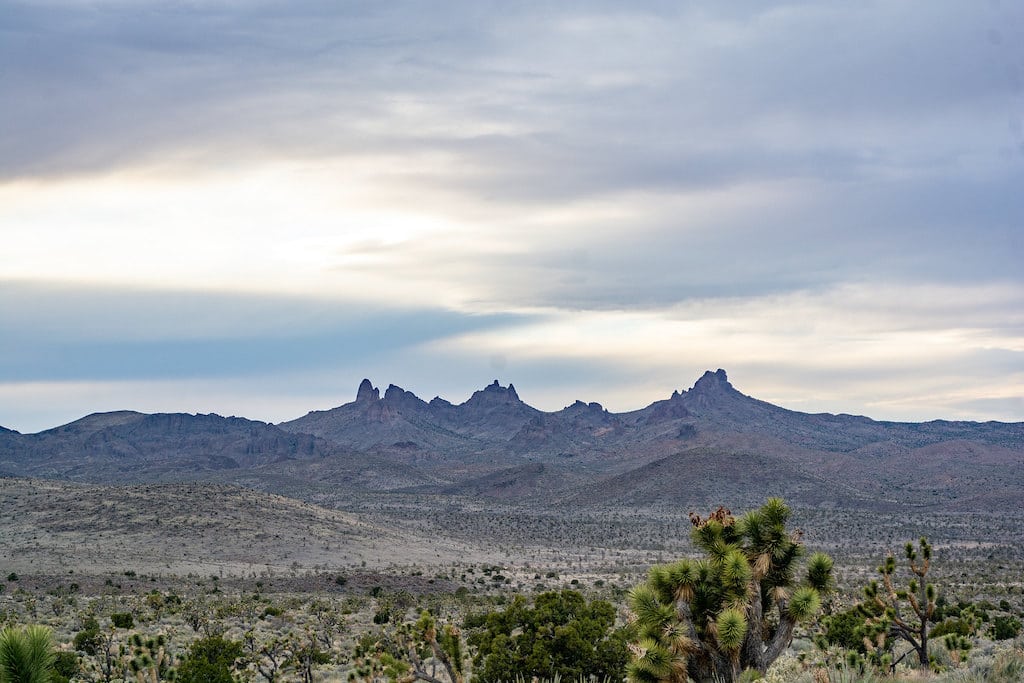
Since this is a newer and quite remote national monument, there isn’t a lot of information about it found online. But the national monument offers some major attractions like spring wildflowers and beautiful Joshua trees. You can find out more about the best time to visit here.
7. César E. Chávez National Monument
César E. Chávez led farm workers to create the country’s first permanent agricultural unions and is often recognized as the most important Latino leader in the United States during the twentieth century.
The property the monument sits on is known as “Nuestra Señora Reina de la Paz” (La Paz) and was the headquarters of the United Farm Workers and César Chávez’s home from the early 1970s until his death in 1993.
There’s a visitor center and memorial garden (where Chavez and his wife are buried) that are open to the public but other areas of the monument are closed to the public since the Chávez family still lives there and UFW offices are located on the property.
8. Mojave National Preserve
Formerly known as the East Mojave National Scenic Area, the Mojave National Preserve is a vast area located in the Mojave Desert of San Bernardino County, California. It’s the third largest unit of the National Park System in the contiguous United States and there’s plenty to explore here.
You can choose from a lot of different hikes on developed trails or you can go for primitive routes. One of the most interesting hikes has to be the Kelso Dunes. These dunes are capable sometimes called the singing sand dunes because of their ability to emit sounds when conditions are right.
It’s a fascinating occurrence but it’s possible to slide down these sand dunes to create sounds that echo out from within the sand dunes. What’s even crazier is that these sounds are set to the keys of E, F, and G, depending on the thickness of the sand layer. You can watch and listen to how this natural phenomena works here.
9. Santa Monica Mountains National Recreation Area
The Santa Monica Mountains National Recreation Area is the largest urban national park in the United States and home to more than 500 miles of trails. It is a very accessible recreation area right outside of the busy metropolis of L.A.
When it comes to hiking the options are numerous with easy, moderate, and strenuous 60+ miles trails to choose from. Mountain biking is also another major draw here along with camping.
Other national parks in California to check out
There are a few other national parks you’ll probably want to check out if you’re heading to California.
While not exactly located in Southern California, Yosemite National Park is a must-see when in the state of California. Yosemite National Park is about 4.5 to 5 hours outside of Los Angeles, depending on the traffic.
You can read up on things to do at Yosemite here.
Another lesser-known national park is Pinnacles National Park. This park is also about 4.5 hours north of Los Angeles and it’s home to some very dramatic scenery that’s worth checking out. Read more about Pinnacles National Park here.
And finally, if you want to head more north, check out Lassen Volcanic National Park, which is full of lava tubes and volcanic rock formations.
Final word
National Parks in Southern California come in all different shapes and sizes. You can check out some of the most unique terrain and flora at many of these parks and brush up on your history and geology knowledge at several of these parks.
Daniel Gillaspia is the Founder of UponArriving.com and the credit card app, WalletFlo. He is a former attorney turned travel expert covering destinations along with TSA, airline, and hotel policies. Since 2014, his content has been featured in publications such as National Geographic, Smithsonian Magazine, and CNBC. Read my bio.

